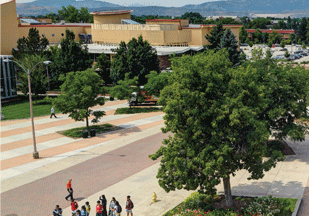
Colorado State University Case Study
Background
Boasting almost 200 buildings and three distinct campus locations—sits Colorado State University (CSU), a school founded in 1870 that enrolls more than 31,000 students, 1,700 faculty members and 2,800 administrative workers. The university has eight dedicated colleges spread out across the main campus located in the heart of Fort Collins, with South and Foothills campuses located a few miles away, and an agriculture campus located 12 miles away.
Challenge
In 2011, it became clear that the university needed to upgrade a number of its buildings to be better prepared for the 21st century academic environment. With both new and old buildings to account for from a security and risk management perspective, CSU was in search of a safe, reliable and networked fire alarm and emergency communications system (ECS).
“We were looking to upgrade and expand our system, so we were seeking answers,” Aaron Pettigrew, network specialist at CSU, said. “That’s the moment we started interviewing several companies. Right away it was clear that Mountain Alarm and NOTIFIER had the experience that we needed. Their solid expertise, loyalty and responsiveness stood out right away.”
According to C.J. Simonds, vice president/general manager of Mountain Alarm, who oversaw the upgrade project, CSU’s chief concern was a large number of antiquated buildings protected by assorted makes and models of systems. The college was facing the big question of what should come next for securing its campus, and CSU worked in tandem with Mountain Alarm to explore ideas, specifically what should be prioritized as far as building a modern network.
The fire alarm systems in a handful of CSU buildings had recently been upgraded to include voice evacuation and the university is looking to integrate ECS on top of that. The campus was in need of a network upgrade as its legacy network was plagued by a lack of redundancy. In addition, the fire alarm information provided by older graphic monitoring systems was not clear enough for dispatchers to direct emergency responders to the proper location.
Solution
When Mountain Alarm approached CSU about a potential solutions fire alarm and ECS network, the timing could not have been better. Echoing a similar sentiment, Simonds explained: “At the time, northern Colorado had just had major flooding to the point where lives were lost and property was damaged. It was the right timing for us to come in and present them with a playbook of ideas that touched on the importance of proper emergency notification and communication.”
After a series of meetings between CSU and Mountain Alarm, including one at NOTIFIER’s Customer Experience Center in Northford, Connecticut, the following solution was proposed:
- Install five NOTIFIER ONYXWorks stations to replace the existing, disparate graphic monitoring workstations
- Build graphics for the school’s 168 buildings so that, in the event of an emergency, a graphic rendering of the floor plan can be pulled up on the workstation, allowing responders to quickly locate the emergency site
- Construct seven redundant subnetworks with 16 gateways installed
- Install NOTIFIER fire alarm systems in all buildings with integrated Digital Voice Command (DVC) to serve both the fire protection and ECS needs of the campus, and enable targeted emergency communications within any or all buildings through the network
- Leverage the 27 miles of fiber network that had been previously installed
Results
Though facets of the project are still underway, CSU has already been able to enjoy sizeable benefits with the upgrade. According to Pettigrew, since the project has begun, the school has experienced fewer false alarms and quicker responses from the fire and police departments.
“Being able to zoom into a floor plan has not only been beneficial for first responders but for our service techs on campus as well,” Pettigrew said. “They can respond faster than what we had prior to this. When you know immediately that you have a problem, and someone is watching it 24/7, you can quickly delegate the proper support that is needed whether it’s a trouble or maintenance issue or a serious fire hazard. This system communicates. There is no lag and you don’t see any failure in this equipment.”
Because the system can properly communicate the type and location of a problem, the school has been able to save a considerable amount of money on labor and workload, according to Pettigrew.
Perhaps most importantly, the university has been able to provide a heightened level of safety since upgrading the buildings. Protecting students, faculty, visitors and university stakeholders, CSU’s top priority with any capital renovation project is safety.
“But there is still more work to be done,” reminds Simonds. “I think the greatest part of this project is that it’s ongoing,” he said. “We will continue to educate where we can and bring technology into the picture to make sure that they have the safest campus possible. And that’s the biggest part. Safety and the importance of their students have always been on the forefront of every conversation.”